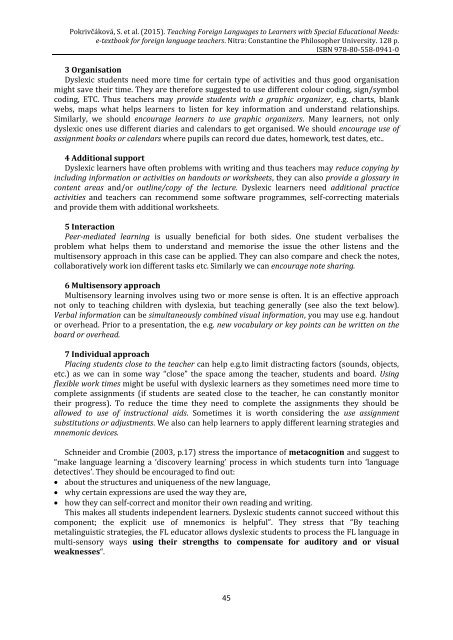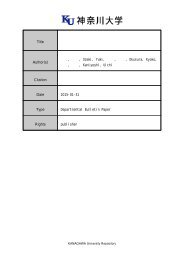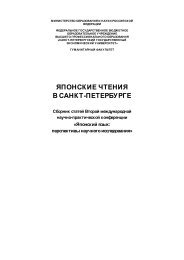to Learners with Special Educational Needs
e-textbook SEN
e-textbook SEN
You also want an ePaper? Increase the reach of your titles
YUMPU automatically turns print PDFs into web optimized ePapers that Google loves.
Pokrivčáková, S. et al. (2015). Teaching Foreign Languages <strong>to</strong> <strong>Learners</strong> <strong>with</strong> <strong>Special</strong> <strong>Educational</strong> <strong>Needs</strong>:<br />
e-textbook for foreign language teachers. Nitra: Constantine the Philosopher University. 128 p.<br />
ISBN 978-80-558-0941-0<br />
3 Organisation<br />
Dyslexic students need more time for certain type of activities and thus good organisation<br />
might save their time. They are therefore suggested <strong>to</strong> use different colour coding, sign/symbol<br />
coding, ETC. Thus teachers may provide students <strong>with</strong> a graphic organizer, e.g. charts, blank<br />
webs, maps what helps learners <strong>to</strong> listen for key information and understand relationships.<br />
Similarly, we should encourage learners <strong>to</strong> use graphic organizers. Many learners, not only<br />
dyslexic ones use different diaries and calendars <strong>to</strong> get organised. We should encourage use of<br />
assignment books or calendars where pupils can record due dates, homework, test dates, etc..<br />
4 Additional support<br />
Dyslexic learners have often problems <strong>with</strong> writing and thus teachers may reduce copying by<br />
including information or activities on handouts or worksheets, they can also provide a glossary in<br />
content areas and/or outline/copy of the lecture. Dyslexic learners need additional practice<br />
activities and teachers can recommend some software programmes, self-correcting materials<br />
and provide them <strong>with</strong> additional worksheets.<br />
5 Interaction<br />
Peer-mediated learning is usually beneficial for both sides. One student verbalises the<br />
problem what helps them <strong>to</strong> understand and memorise the issue the other listens and the<br />
multisensory approach in this case can be applied. They can also compare and check the notes,<br />
collaboratively work ion different tasks etc. Similarly we can encourage note sharing.<br />
6 Multisensory approach<br />
Multisensory learning involves using two or more sense is often. It is an effective approach<br />
not only <strong>to</strong> teaching children <strong>with</strong> dyslexia, but teaching generally (see also the text below).<br />
Verbal information can be simultaneously combined visual information, you may use e.g. handout<br />
or overhead. Prior <strong>to</strong> a presentation, the e.g. new vocabulary or key points can be written on the<br />
board or overhead.<br />
7 Individual approach<br />
Placing students close <strong>to</strong> the teacher can help e.g.<strong>to</strong> limit distracting fac<strong>to</strong>rs (sounds, objects,<br />
etc.) as we can in some way “close” the space among the teacher, students and board. Using<br />
flexible work times might be useful <strong>with</strong> dyslexic learners as they sometimes need more time <strong>to</strong><br />
complete assignments (if students are seated close <strong>to</strong> the teacher, he can constantly moni<strong>to</strong>r<br />
their progress). To reduce the time they need <strong>to</strong> complete the assignments they should be<br />
allowed <strong>to</strong> use of instructional aids. Sometimes it is worth considering the use assignment<br />
substitutions or adjustments. We also can help learners <strong>to</strong> apply different learning strategies and<br />
mnemonic devices.<br />
Schneider and Crombie (2003, p.17) stress the importance of metacognition and suggest <strong>to</strong><br />
“make language learning a ‘discovery learning’ process in which students turn in<strong>to</strong> ‘language<br />
detectives’. They should be encouraged <strong>to</strong> find out:<br />
about the structures and uniqueness of the new language,<br />
why certain expressions are used the way they are,<br />
how they can self-correct and moni<strong>to</strong>r their own reading and writing.<br />
This makes all students independent learners. Dyslexic students cannot succeed <strong>with</strong>out this<br />
component; the explicit use of mnemonics is helpful”. They stress that “By teaching<br />
metalinguistic strategies, the FL educa<strong>to</strong>r allows dyslexic students <strong>to</strong> process the FL language in<br />
multi-sensory ways using their strengths <strong>to</strong> compensate for audi<strong>to</strong>ry and or visual<br />
weaknesses“.<br />
45






